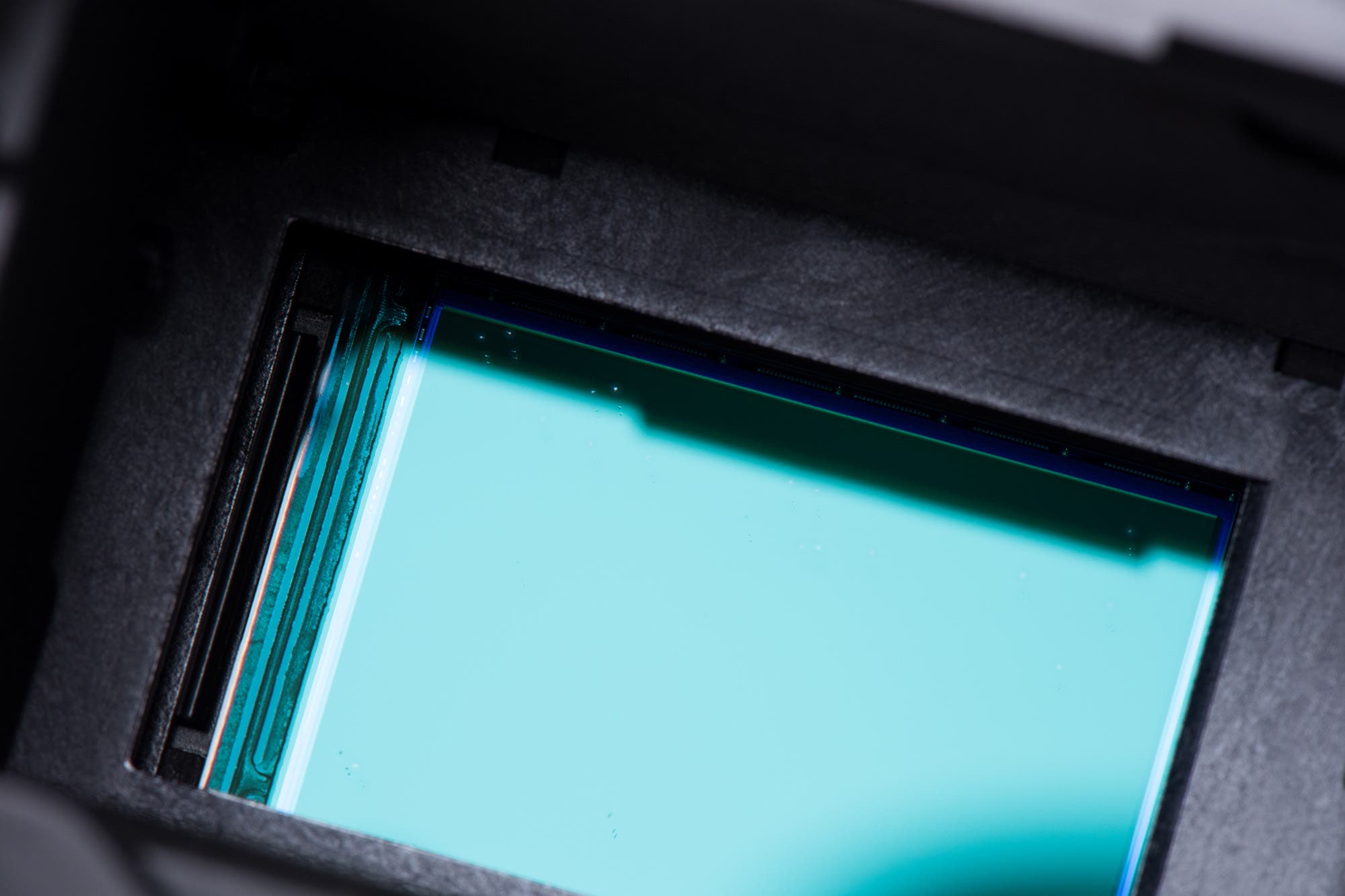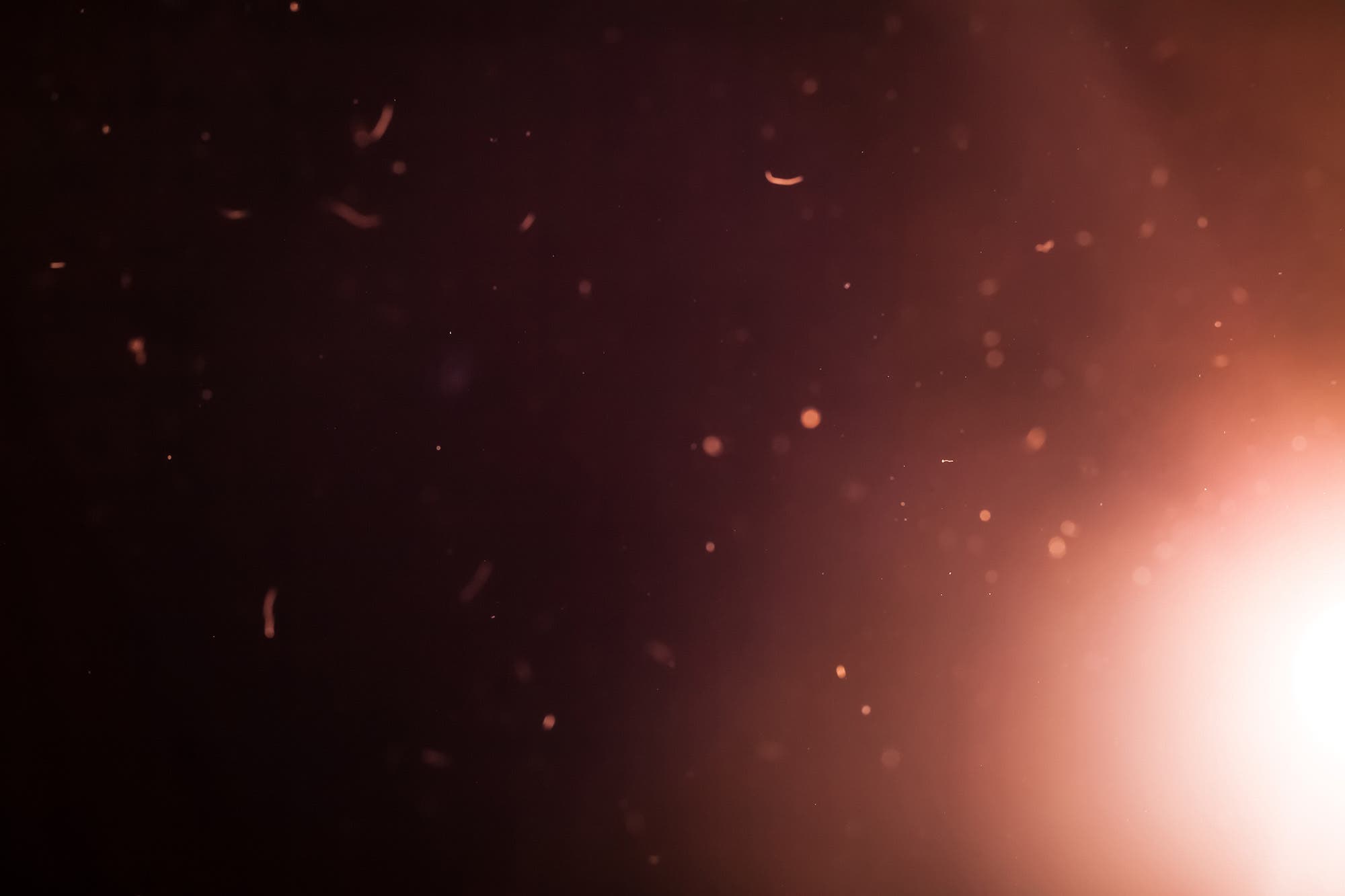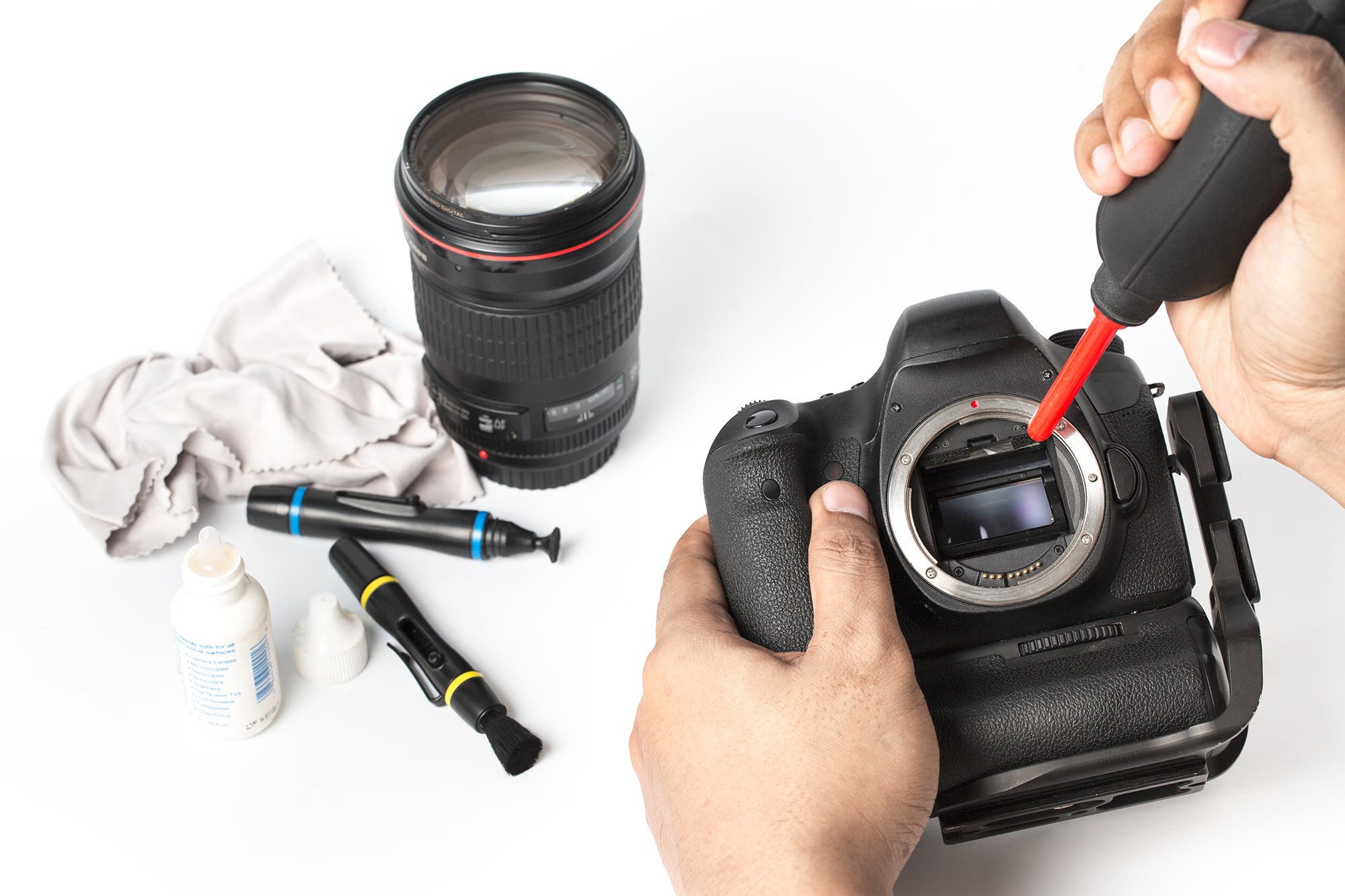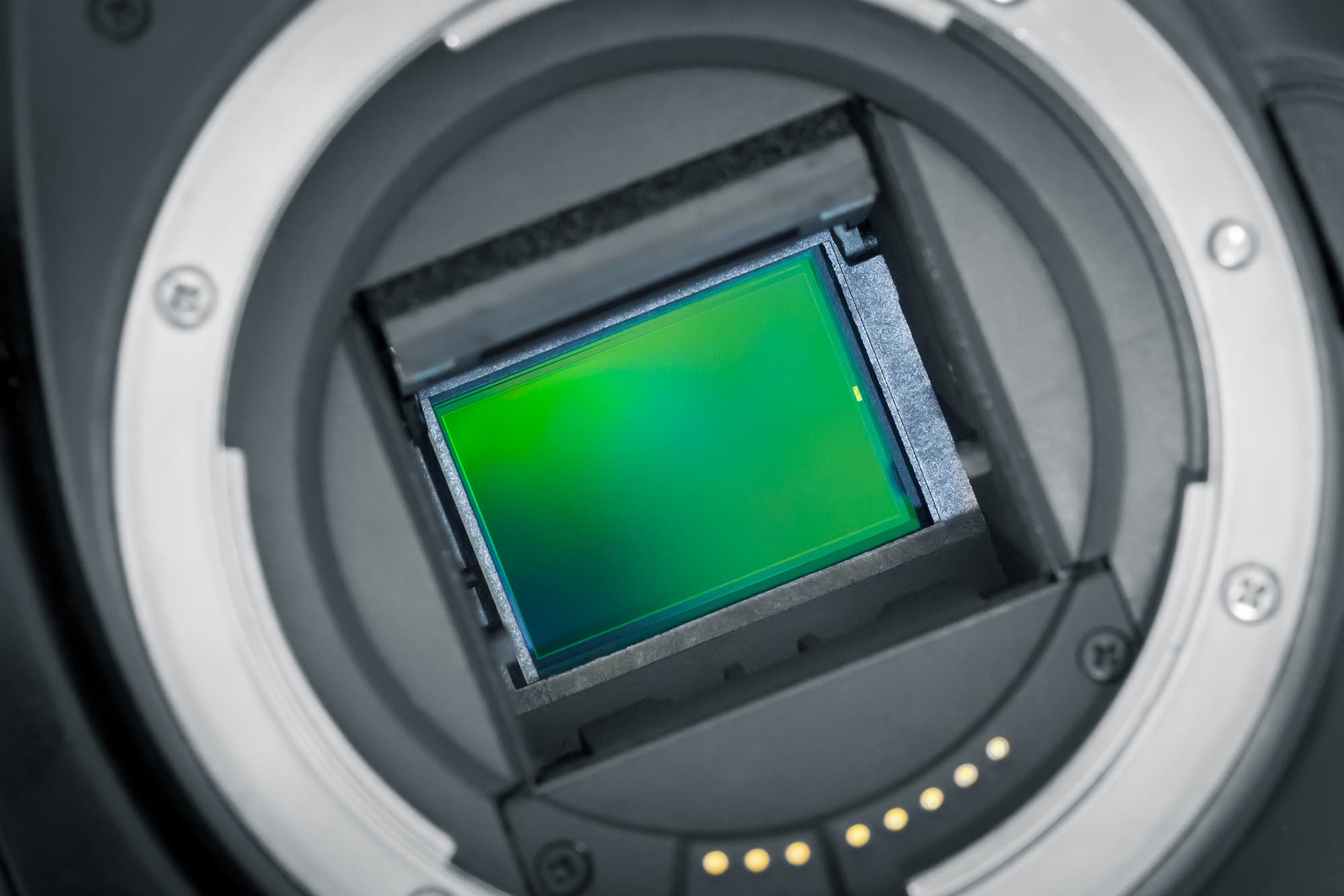How To Clean Camera Sensor Canon
How to Clean Camera Sensors: The Secret to Safely and Effectively Cleaning Sensor Dust
Accept you ever wondered what causes those mysterious spots that appear in your photos? For photographers, particularly those who employ interchangeable lens cameras, this is a mutual occurrence.
If you are constantly using your camera and switching lenses during photo shoots, then yous've probably experienced this problem before.
These mysterious spots are acquired by dust or dirt on your sensor, which is completely normal and almost unavoidable. To gainsay this problem, nearly camera makers have included a sensor cleaning function in newer camera models. Even so, sometimes this handy footling feature only isn't enough, which is why cleaning the camera sensor is a painstaking task that every lensman has to deal with every and so often.
What is sensor dust?

The term sensor dust is used to describe the particles or elements that enter a photographic camera and stick to its sensor. This normally happens when the camera user exposes the sensor past removing the trunk cap or switching lenses.
Camera sensors are grit magnets and notoriously prone to dust buildup if yous're non careful, so you will inevitably have to clean your camera's sensor every so ofttimes, or once you showtime to discern those annoying spots on your photos.
Why is sensor grit a problem?

If you're not professionally selling your photos, sensor dust really isn't a big deal. As long as you're satisfied with the photos, you can just ingather them out (if they're virtually the edges) or use Photoshop to become rid of them.
But if yous're a professional photographer who takes hundreds of photos in a single photo shoot, these quick fixes aren't appropriate since information technology would be as well fourth dimension-consuming to have to edit out sensor dust in every single pic. So, if you exercise this for a living, yous'll have to continue your photographic camera'due south sensor clean at all times.
Are cocky-cleaning sensors sufficient?
You can't always rely on new technology to assure yous of a clean digital camera sensor. Many interchangeable lens cameras—DSLRs and MILCs—fabricated in recent years have self-cleaning sensors that vibrate at ultrasonic speeds when the photographic camera is turned on or off. This may help shake some of the clay loose, but it shouldn't exist a substitute for transmission sensor cleaning.
With a cocky-cleaning sensor, you may not demand to make clean your sensor every bit often, simply it still needs to be cleaned manually every once in a while to ensure that it's completely dust-free. Some photographers commonly ship it in to the manufacturer'south service heart for cleaning, merely due to the meaning downtime (information technology will take a while for yous to get your camera back) and the expensive price, well-nigh just end upwards doing it themselves.
If you lot're planning on going the DIY road, you can notice a lot of information online and elsewhere most how to clean camera sensors, but I believe my sensor cleaning method is more thorough than whatever others I've seen.
Even with cocky-cleaning, sensor spots are actually more than of an upshot today than they were a few years agone. Image manipulations such as HDR or the tone mapping-similar contrast increases, including those in many popular filters such as those from Nik and Topaz, will show spots that y'all didn't find before.
Is DIY sensor cleaning safe?

DIY sensor cleaning is completely safe. Equally long as you do it the right manner, you lot shouldn't have whatsoever bug. Many photographers regularly exercise their ain sensor cleaning without any issues. Yes, there's always the hazard of dissentious the sensor if done incorrectly, but if yous take a few basic precautions and handle your sensor with care, the potential for damage is small.
At that place has been a lot of fence on the claim of do-it-yourself versus sending information technology out when it comes to cleaning sensors. Having it cleaned past professionals is ultimately the easier option, merely equally previously mentioned, it will cost you coin and you won't exist able to utilize your camera for a certain period of time. I personally want to exist able to clean my sensor whenever necessary, which can be at inconvenient times, and I want to have it done quickly. And, frankly, I remember I'd practise a better chore than anyone else.
Sensor cleaning tin can exist tiresome, and information technology'south a chore that y'all wouldn't want to entrust to just anyone. Sometimes it gets worse before it gets improve, just I'll stay at it until I'm satisfied with the results.
Knowing how to clean your ain photographic camera sensor is not only economical and convenient, just ultimately more effective and thorough because you lot are doing the work yourself. You can save a packet (you'll only need to spend on a reliable photographic camera cleaning kit) and do a meliorate job by cleaning your camera'due south sensor yourself.
How to check if your sensor is dirty
It'due south piece of cake to find out how dirty the sensor is by shooting a clear sky or a make clean piece of paper. It will give yous an idea of what you'll need to clone out on the images, as well as how badly y'all need to clean the sensor.
1. Shoot a sensor check image
- Set your lowest "normal range" ISO (100 for Canon and 200 for Nikon). Don't set a lower ISO that is in the "extended range." Y'all'll get the lowest noise at your lowest normal ISO.
- You want the shot to be out of focus, then ready transmission focus and focus to infinity for a piece of paper and close-focus for the sky.
- Gear up to f/22, so any spots will be well defined. At a wider aperture such as f/5.half-dozen, they may non testify, and at a smaller discontinuity such as f/32, you may see too much detail. (The spots are shadows of stuff that is on a drinking glass surface in front of the sensor itself.)
- If you're shooting a piece of newspaper indoors, you'll take a slow shutter speed. That's fine; you want to blur the subject every bit much as possible anyway, so become ahead and paw concord. You just want to shoot featureless light.
- You want a somewhat telephoto focal length to shoot a small-scale segment of the target and to minimize any tonal gradients. It depends on the evenness of the illumination of your target, of grade, just 70-100 mm is usually fine.
- If you're a JPEG shooter, make sure you're using the highest quality and largest file size. (I would hope yous are, anyhow.)
2. Post-process to find the spots
At present here's what to practice with the test paradigm (just looking at it on the back of the camera volition evidence the really atrocious spots):
- Open the image on the computer and desaturate, either in the RAW converter or in Photoshop.
- You might see some spots at this point, but to really see what's there:
-Make a Levels adjustment layer above your Background image.
-Become to Layer > New Adjustment Layer > Levels, or utilize the black and white circle icon at the bottom of the Layers panel/palette.

- In the Layer aligning, the narrowness of the histogram peak will indicate how much tonal slope you've captured. The narrower, the better, but no need to go it super narrow.
- Increment contrast by bringing in the two end sliders to meet the ends of the peak, and you'll really see what's on the sensor. You lot'll also see some darkening in the corners due to the normal light falloff in the lens.

Here, you can run across a piece of lint bottom-center and a spot on the left. There are many more spots that you can't see in this minor web image.
The image a lens projects onto the sensor is upside-down, and when the camera processes the paradigm, it'southward flipped right side up. So the image of the sensor you see has been flipped, and the piece of lint is actually at the tiptop of the sensor
Seeing something similar this, you know you need to clean the sensor. Find the item in your photographic camera card that flips up the mirror and lets y'all access the sensor.
What to do before cleaning the sensor?
- Make sure you have a fully charged bombardment. If the bombardment runs out while you lot're working in the sensor sleeping accommodation, the mirror will slap down and you'll accept to bargain with a very expensive repair. The same goes for inadvertently nudging the bill of fare door enough to "open" it.
- Make clean your photographic camera'due south exterior body. It'due south important that you clean the exterior earlier you lot move on to what's inside. If you neglect to do and then, dust particles could enter your sensor.
- Detect cleanliness in the expanse. Make sure that the place where you're going to clean your DSLR camera sensor is clean and dust-free. You don't want more dust to add to the dirt that you're trying to remove.
- Gather all the necessary tools. Yous don't want to outset the sensor cleaning procedure so realize later on that you don't have a certain tool. If you lot don't own a complete camera cleaning kit withal, make sure to gather all the needed sensor cleaning tools before you proceed.
Dry cleaning method for DSLR camera sensor:
Tools for dry cleaning your camera sensor:
- Transmission air blower to eliminate bigger dust particles
- Sensor scope to check for uncleared spots
How to clean camera sensor using the dry method:
- Lay the camera down on a table instead of holding it. Don't touch anything every bit yous make clean.
When I see large dust pieces, I outset the cleaning process by bravado on the sensor with an air bulb such every bit the Giottos rocket air blaster. (Doing and so allows me to safely hold the photographic camera and turn it upside down considering the bulb tip doesn't accept to exist within the bedchamber).Reminder: Never employ canned air; the propellant can create a residual on the sensor that will probably need professional removal. Big pieces volition often accident off and autumn out of the chamber.
- I'll blow on the mirror before I put information technology up. And I'll blow off the back of the lens, too. There'southward so much grit everywhere; I might as well get rid of whatever I can. The sensor has an electrostatic charge when the camera is on in its normal way (simply not in sensor cleaning style) and information technology will attract dust like a magnet.
- At this betoken, I find a sensor telescopic very handy. Information technology's a magnifying glass with a light shining on the sensor (I similar the Delkin sensor scope). You lot'll see sensor dust equally tiny silvery threads or spots.
- I'll repeat the air bulb and sensor scope check until I've gotten what I tin, and so shoot a piece of paper to encounter if I had any luck bravado off some of the smaller spots. Usually, the answer is no.
- I'll go later on the smaller spots that I can see only in the Photoshop paradigm. They may wait much less pregnant, but they'll show up when you do many image manipulations. You'll want to zoom in on the paradigm to see these smaller spots.
Here'due south a 50% zoom of the in a higher place sensor check epitome. This is not a good thing. The smallest and lightest spots aren't of much significance, but the others are.

Wet cleaning method for DSLR camera sensor:
If that happens, the next pace is to use a sensor cleaning castor. These are very special brushes whose bristles hold an electrostatic charge and attract particles off the sensor, rather than "sweeping" them off, and so just a calorie-free affect is needed.
Reminder: These brushes need to exist kept very make clean. You accuse them correct earlier use past blowing on the beard with a squeeze bulb or past spinning the bristles with the battery-powered Visible Dust Chill Butterfly. (Practice not spin information technology while it is in the sensor chamber).
Tools for wet cleaning your DSLR camera sensor:
I use sensor cleaning products from Visible Dust, but I tin't claim they're better than any other:
- Chill Butterfly castor
- Light-green swabs
- Sensor Make clean solution
- Smear Away solvents
How to clean camera sensor using the wet method:
There is information on the manufacturer's website most sensor cleaning and proper use of its products. And the solvents (or at to the lowest degree some of them) are said to leave a coating on the sensor that helps repel grit and minimizes dust build-up.
Here are the steps to wet clean your sensor:
- Read the product directions very advisedly.
- The swabs should be kept very clean and should be advisedly moistened right on the edge, with ii drops of solvent, each one placed one-4th of the way in from the edge, to evenly wet the edge.
- Let the solvent soak in a minute or so before swabbing. You don't desire to squeeze out liquid on the sensor glass.
- Tilt the swab and elevate it in one laissez passer from one edge of the sensor to the other, so turn it over and drag it back the other way, so the other side of the edge is being used. (Check the manufacturer'southward website for video demos.) Y'all'll need some pressure level with the swab, unlike the brush.
When to utilize the Smear Abroad and Sensor Clean solvent:
Brushing normally won't remove all the spots, and you'll need to resort to swabs and solvents. After brushing, you'll need to echo the shot of the sky or a slice of newspaper, and if you see an elongated smear, you've brushed through an oil spot thrown by the shutter.
In this instance, yous'll need to clean the brush in its recommended style earlier using it again, and you'll need to use solvents to remove the oil.
- If I see an oil smear, I use the Smear Away solvent, which needs to be followed past the Sensor Clean solvent. The swabs may leave lint, so another loupe inspection is in lodge, followed past the blower and if, needed, the castor. (I have two, so if I brush through oil, I tin go along cleaning.)
- If in that location is no oil smear, I just use Sensor Clean. Regardless of the solvent, it may take several passes, each with a clean swab, to get everything make clean. And junk may exist pulled in from the edges of the sensor, making things worse before they become ameliorate. But they'll go better.
Finishing steps in cleaning a DSLR camera sensor:
At the phase when I can no longer meet whatever dust or spots with the loupe, I repeat the sensor bank check by shooting a slice of plain paper again. It may take several repetitions to get things clean, but I call up information technology's worth the problem.
There is some other Visible Dust solvent that I can't recommend: VDust. I'm not in the business of cleaning sensors, simply of the few I've done for friends, I've cleaned two that showed a very foreign wait when the contrast was increased with Levels, as if at that place'southward a liquid on the surface that didn't "moisture" information technology.
In my outset experience with this product, I used the person's cleaning kit, which included the VDust solvent. In the second case, when I did an initial Levels bank check, I saw that same await and found the person had been using VDust according to directions, and the sensor had been in this condition for many weeks.
In both cases, I used Sensor Clean and managed to go the balance off, merely it took many passes with clean swabs each time. I have no idea what's going on here. Afterwards the first incident, I emailed the company, just they're not interested in my experience and insisted that the production was fine.
Sometimes, you'll see a much larger and dimmer spot on the sensor. Mine are always hexagonal, reflecting the aperture leaves in the lens. These are not on the sensor but are bits of dust or dirt on the lens, either the front or rear surfaces.

It's very important to go along the rear chemical element of the lens and the sensor loupe make clean, equally dust can leap or autumn from them onto the sensor.
In that location are besides products to clean the walls of the sensor bedroom. Although there'south no piece of cake way to assess their effectiveness, I'grand in favor of keeping things as make clean equally I can.
Tips for keeping your camera sensor make clean:
Prevention is the ultimate cure. If you don't want to constantly worry near sensor dust, you need to take steps to prevent it from finding its way into your camera.

- When changing lenses, make sure information technology's washed in a make clean place where there'due south however air. Always bespeak the camera toward the ground, and then the dust particles (if there are any) won't state on your DSLR's sensor.
- Avert unnecessary changing of lenses. Also, make certain that the lens cap is clean before covering up your lens optics.
- Make sure your camera's handbag is make clean. Clean information technology once in awhile to avoid clay and dust buildup.
The sensor cleaning procedure can be dull. But how confident will you be that, if you send your camera out to exist cleaned, information technology volition be done with sufficient attention to detail? At to the lowest degree, now y'all have a means to cheque it afterward the fact.
Source: https://www.adorama.com/alc/the-secret-of-effectively-and-safely-cleaning-your-digital-camera-sensor-yourself/
Posted by: williamsalksomed.blogspot.com



0 Response to "How To Clean Camera Sensor Canon"
Post a Comment